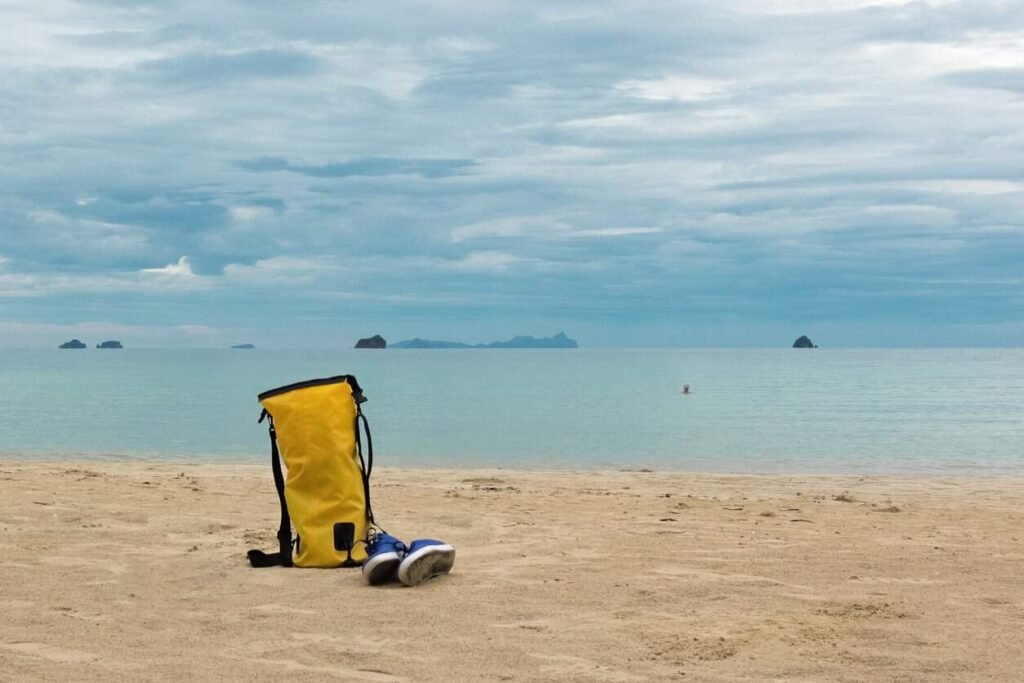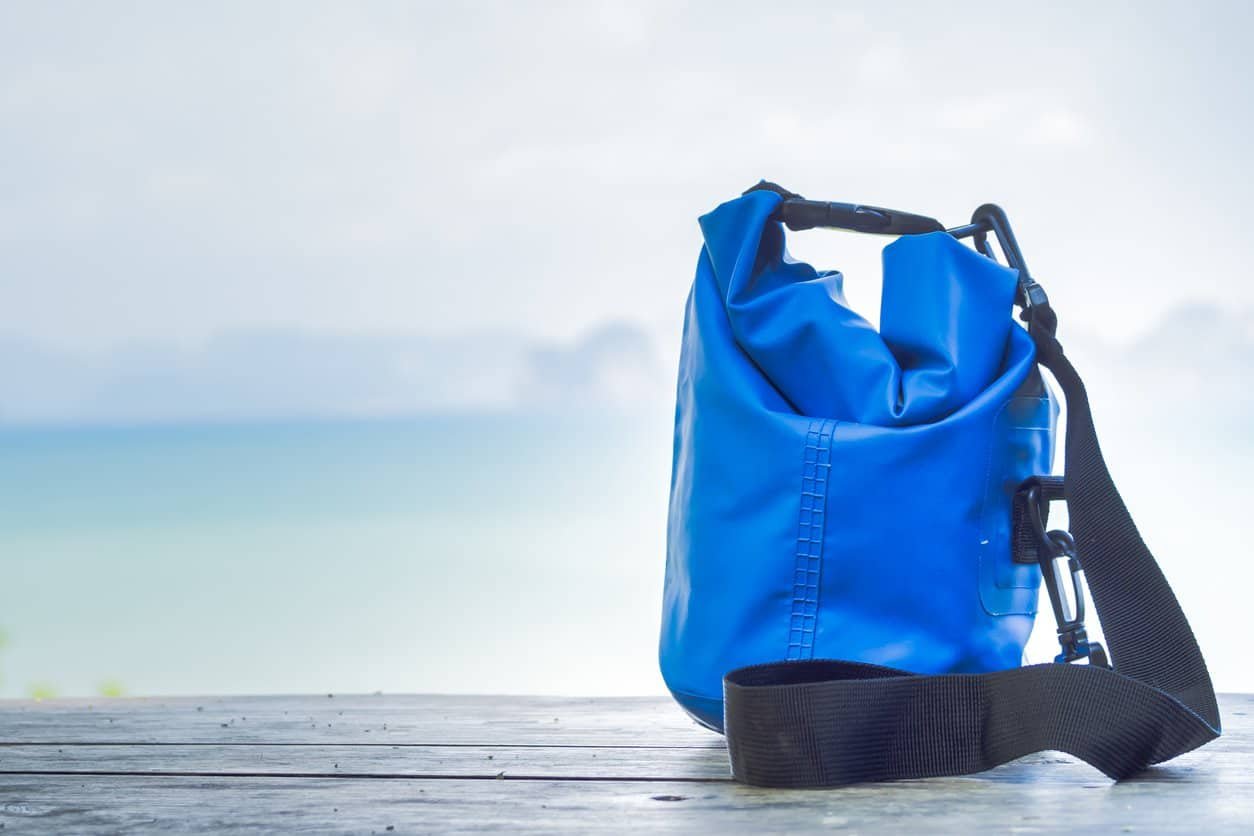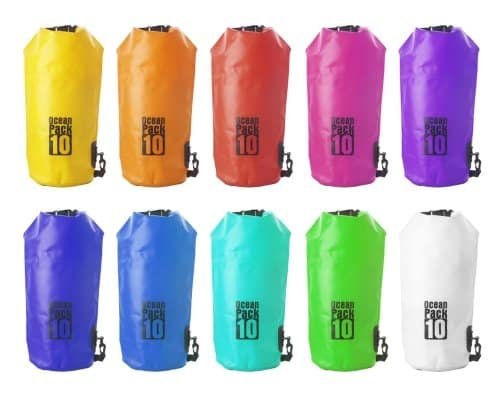Whether you’re an avid adventurer braving the wild rivers or a casual traveler looking to protect your gear from the elements, understanding the essentials of a dry bag is crucial. These specialized bags are designed to withstand the rigors of outdoor activities, offering a reliable barrier against water, dust, and sand. This comprehensive guide will delve into everything you need to know about dry bags, from their construction and materials to choosing the right size and features for your specific needs. Equipped with a dry bag, you can confidently venture into any environment, knowing your belongings are safeguarded, allowing you to focus on the adventure at hand.

What Is A Dry Bag?
A dry bag is an essential piece of equipment designed for a variety of outdoor activities where keeping personal items dry is crucial. This type of bag provides an effective barrier against water, dust, and sand, ensuring that contents such as electronics, clothing, and important documents remain protected under adverse conditions. Here’s a detailed look at the characteristics and functionality of a dry bag:
Definition and Design
- Waterproof Construction: Dry bags are crafted from waterproof materials such as PVC, vinyl, or coated nylon, which prevent water from penetrating the bag. The materials are chosen for their durability and resistance to abrasions, punctures, and UV damage.
- Sealing Mechanism: The top of a dry bag typically features a roll-top closure, where the opening of the bag is folded down several times and then buckled together. This design not only seals out water but also traps air inside, allowing the bag to float if dropped in water.
Varieties and Features
- Sizes and Shapes: Dry bags come in a range of sizes, from small pouches suitable for items like smartphones and wallets to large bags capable of holding gear for a multi-day expedition. Some are designed with flat bottoms or include straps and handles for easier carrying.
- Colors and Visibility: They are often available in bright colors or with reflective patches to enhance visibility in low-light conditions, which is especially useful in emergency situations or during water sports.
Uses and Applications
- Outdoor Sports: Commonly used in kayaking, boating, rafting, and other water sports, dry bags keep gear dry and float on the water’s surface if accidentally dropped.
- Camping and Hiking: For activities in humid, muddy, or rainy environments, dry bags protect spare clothes, electronics, and sleeping bags from moisture.
- Travel: Useful for beach trips, snorkeling, or any situation where protection from water is necessary, dry bags help travelers safeguard their belongings against potential water exposure.
Benefits
- Protection and Peace of Mind: The primary benefit of a dry bag is the protection it offers. Users can confidently engage in their activities without worrying about water damage to their belongings.
- Versatility and Adaptability: Dry bags are versatile and can be used in various environments, not just aquatic ones. They are excellent for dust and sand protection in desert landscapes or as an organized storage option in snowy conditions.
Dry bags are an indispensable tool for anyone who loves the outdoors or needs to protect their belongings from the elements. With their robust construction and simple yet effective closure systems, dry bags provide a reliable solution for adventurers and travelers alike. Whether you’re navigating the rapids or trekking through rainforests, a dry bag is your ultimate ally in keeping your essentials dry and secure.
Why Should I Use One?
The use of a dry bag is not merely a convenience but a necessity for many outdoor activities and situations where keeping items dry is critical. Understanding why you should use a dry bag can help you appreciate its importance across various scenarios, from adventure sports to daily commuting in unpredictable weather. Here’s an exploration of the significant reasons to use a dry bag:
Essential Protection
- Waterproof Security: The primary function of a dry bag is to provide a waterproof barrier that keeps moisture and water away from sensitive items like electronics, cameras, clothing, and important documents. This is crucial for activities around water, such as boating, kayaking, or during rainy outdoor events, where exposure to water can damage your belongings.
Versatility in Use
- Broad Utility: Dry bags are not only useful for water-related activities but also serve as an effective solution for protecting contents from dust, sand, and mud. They are ideal for beach outings, desert excursions, and muddy hiking trails, where fine particles can be just as damaging as water.
Durability and Dependability
- Long-Lasting Materials: Constructed from tough materials like vinyl, nylon coated with silicone, or PVC, dry bags are designed to withstand harsh conditions, abrasions, and punctures. Their durability ensures that they can be relied upon in rugged environments and provide long-term value.
Safety and Emergency Preparedness
- Emergency Buoyancy: Thanks to their air-tight sealing mechanism, most dry bags can float, providing an extra layer of safety during water sports or accidents. This feature can be life-saving in emergencies, helping to keep stranded belongings within reach or even supporting some weight if needed.
Enhanced Organization and Mobility
- Ease of Transport: Many dry bags come equipped with features like shoulder straps, handles, or lash points that make them easy to carry or attach to other gear. This portability is beneficial for activities where free hands are necessary, and gear needs to be consolidated and easily accessible.
Eco-Friendly and Economical
- Reduces Single-Use Waste: By investing in a reusable dry bag, you contribute to reducing the consumption of single-use plastic bags, which are often used as a quick but unsustainable way to protect items from water.
- Cost-Effective Protection: Although the initial investment in a high-quality dry bag might seem substantial, the protection it offers can save money in the long run by preventing damage to expensive gear and electronics.
In conclusion, using a dry bag is about more than just keeping things dry; it’s about ensuring that your adventures and daily activities are not hampered by damaged gear or lost items. Whether you’re a seasoned adventurer, a casual traveler, or someone who frequently battles the elements, a dry bag is an indispensable tool that enhances your preparedness, safety, and convenience.
How To Pack And Fold A Dry Bag
Packing and folding a dry bag correctly is essential to ensure that it performs its primary function—keeping contents dry and secure. Proper technique not only maximizes the effectiveness of the dry bag but also extends its lifespan. Here’s a detailed guide on how to pack and fold a dry bag for optimal performance:
Packing a Dry Bag
- Select Appropriate Items: Start by choosing items that need waterproof protection. Electronics, important documents, clothing, and food items are typical candidates for dry bag storage.
- Use Dry Bag Liners: For extra security, consider using dry bag liners or smaller dry bags within a larger one to compartmentalize and provide double protection, especially for electronics and other highly sensitive items.
- Avoid Overpacking: Fill the dry bag to about two-thirds full. Overpacking can stress the seams and make it difficult to seal the bag properly, compromising its waterproof capabilities.
Arranging Contents
- Distribute Weight Evenly: Place heavier items at the bottom and lighter items on top. Even distribution helps in carrying the bag more comfortably and ensures it sits well if attached to a kayak, backpack, or other equipment.
- Expel Air as Needed: Depending on the use, you might want to expel excess air to make the bag more compact or keep some air inside to allow the bag to float. Adjust the air volume based on your specific needs.
Folding and Sealing the Dry Bag
- Push Air Out: Before sealing, gently push out any unnecessary air from the top of the bag to reduce bulk and increase the effectiveness of the seal.
- Align the Edges: Make sure the edges of the opening are aligned perfectly. This step is crucial for a tight seal.
- Fold the Top: Fold the top edge over at least three times. Be sure that each fold is tight and creased well. The number of folds is essential—too few can result in water ingress.
- Buckle the Ends: Most dry bags come with buckle closures that should be fastened securely after folding. Ensure the buckle is tight and check that the seal is firm and without any gaps.
Additional Tips
- Check for Wear and Tear: Before each use, inspect your dry bag for any signs of wear, punctures, or seam damage. Address any issues before packing to ensure the integrity of the waterproofing.
- Practice at Home: If you’re new to using dry bags, practice packing and sealing at home before heading out. This practice can help you get comfortable with the process and ensure you know how to secure your items effectively.
By following these steps, you can rest assured that your belongings will stay dry and safe, no matter the adventure. Packing and folding your dry bag properly is a simple yet crucial skill that enhances your experience in the outdoors, providing peace of mind as you explore nature.

Which Size Dry Bag Should I Use?
Choosing the correct size dry bag for your needs is essential to ensure you have enough capacity to store your items without wasting space or carrying excess weight. The size of the dry bag you select will depend on the type of activity you’re engaging in and the items you need to keep dry. Here’s a guide to help you determine which size dry bag is most suitable for your adventures:
Understanding Dry Bag Sizes
- Small (5 liters to 10 liters): These bags are perfect for day trips or when you only need to protect small items like personal electronics, snacks, a small first aid kit, or personal documents. They are compact enough to fit inside or attach to a larger backpack.
- Medium (10 liters to 20 liters): Ideal for overnight trips or more extensive day trips. These bags can hold items such as a change of clothes, a small sleeping bag, or larger electronic devices like a tablet along with other essentials.
- Large (20 liters to 40 liters): Suitable for multi-day excursions where you need to carry multiple changes of clothes, larger sleeping equipment, or several days’ worth of food supplies. These are often used in water sports like kayaking or canoeing where larger, bulkier items need protection.
- Extra-Large (40 liters and above): These are best for long expeditions, especially in group settings where communal equipment needs to be protected, like cooking gear, large tents, or bulk supplies. They’re also ideal for situations where everything must be kept in a single bag that can be easily transported, such as during boat trips or when portaging.
Factors to Consider When Choosing a Dry Bag Size
- Duration of Trip: Longer trips require larger bags to accommodate more supplies. Consider not just clothing but also food, cooking gear, and emergency supplies.
- Type of Activity: Different activities demand different gear. For instance, water-based activities might require additional dry bags for safety gear or navigation tools, whereas hiking might focus more on food and clothing.
- Packability and Weight: Larger dry bags offer more space but are heavier and bulkier. Assess the trade-offs between space and the practicality of carrying a larger or heavier bag.
- Modularity: Sometimes using several smaller bags for different types of gear is more practical than one large bag. This approach can make organizing and accessing items easier and allows you to distribute weight more effectively among a group or within a boat.
Additional Tips
- Always Opt for Slightly Larger: If unsure, choose a bag slightly larger than you think you might need. Having a bit of extra space can be helpful, especially if you encounter unexpected items or purchases that need protection.
- Consider Compressibility of Contents: If you’re carrying items that can be compressed, like down jackets or sleeping bags, you might be able to opt for a smaller dry bag than initially thought.
- Multiple Bags for Organization: For ease of access and better organization, consider using multiple smaller bags categorized by item type (e.g., one for clothing, one for electronics) instead of one large bag.
Selecting the right size dry bag is a balance of your needs, the nature of your trip, and the items you require to stay dry. By carefully considering these factors, you can choose a dry bag that not only protects your gear but also enhances your overall experience in the outdoors.
How To Choose The Right Bag For Your Adventure
Choosing the right dry bag for your adventure is critical to ensure that your gear remains dry and protected, regardless of the conditions you face. Here’s a comprehensive guide to selecting the most appropriate dry bag based on the specific needs of your activity:
Assess Your Needs
- Activity Type: Different outdoor activities have varying requirements. For water-based activities like kayaking, canoeing, or rafting, look for dry bags with additional waterproofing and buoyancy features. For hiking or camping, consider durability and ease of carrying.
- Duration of the Trip: The length of your adventure will determine the size and number of dry bags you need. Longer trips require larger bags or multiple bags to accommodate all necessary equipment.
Consider the Material
- Durability and Weight: Materials like nylon coated with silicone are lightweight and suitable for backpacking where weight might be a concern. PVC and vinyl are heavier but offer superior durability and water resistance, ideal for rough water sports.
- Waterproof Rating: Check the waterproof rating of the material. Some bags are only water-resistant and suitable for light moisture, while others can withstand being submerged briefly.
Check the Closure Type
- Roll-Top Closure: The most common and reliable closure type for dry bags is the roll-top. It provides a secure seal and, when done correctly, prevents any water ingress.
- Zipper Seal: Some dry bags come with a zipper seal which offers easier access but may not be as watertight as a roll-top. Ensure it meets the standards required for your activity.
Evaluate Additional Features
- Attachment Points: Look for dry bags with D-rings or tie-down points if you need to secure the bag to a kayak, boat, or backpack. This feature is crucial for preventing loss in dynamic environments.
- Straps and Handles: For ease of transport, especially when carrying over long distances or during portages, consider bags with shoulder straps, carry handles, or back harnesses.
- Color and Visibility: Brightly colored bags enhance visibility in emergency situations. Reflective strips or patches are useful for low-light conditions.
Determine the Right Size
- Volume Needs: Calculate the volume of gear you need to carry and choose a bag size accordingly. It’s often beneficial to have a combination of sizes for different types of gear, which also aids in organization and accessibility.
- Packability: Consider how the dry bag will fit with your other gear. For backpackers, a more compact, flexible bag might be important, whereas for boaters, sturdier, more structured bags could be preferable.
Test Before You Go
- Waterproof Test: Before heading out, test the dry bag with non-essential items inside to ensure it’s completely watertight.
- Pack Test: Pack the dry bag as you would for your trip to make sure everything fits comfortably and the bag can be sealed properly.
By taking into account these factors, you can select a dry bag that not only meets your specific needs but also enhances your overall outdoor experience. Whether you’re braving the rapids or trekking through lush forests, the right dry bag will keep your essentials protected, allowing you to focus on the adventure ahead.

FAQ
Q1: Can dry bags be fully submerged underwater?
A: While dry bags are designed to be highly water-resistant, not all are meant for prolonged submersion. Roll-top dry bags can handle quick dunks and heavy rain but check the manufacturer’s specifications to ensure suitability for full submersion if required.
Q2: How do I clean my dry bag?
A: Clean your dry bag with mild soap and lukewarm water. Avoid harsh detergents and scrub gently. Rinse thoroughly and air dry with the top open before storing it away.
Q3: Are there dry bags suitable for electronics?
A: Yes, there are specially designed dry bags with padded or reinforced sections to protect electronics. Look for bags with additional shock-absorbing features if you plan to carry delicate gadgets.
Q4: How long do dry bags last?
A: With proper care, a high-quality dry bag can last for many years. The lifespan depends on the frequency of use, the conditions it’s exposed to, and how well it is maintained.
Conclusion
Dry bags are indispensable tools for anyone engaging in outdoor activities where water, dirt, or sand is a concern. From kayaking and rafting to hiking in unpredictable weather, a good dry bag ensures that your gear remains dry, secure, and functional. When selecting a dry bag, consider the specific requirements of your activity, the durability of the material, the type of closure, and the size needed for your gear. With the right dry bag, you can enjoy your adventures to the fullest, confident that your equipment is protected against the elements. Remember, the best dry bag is one that suits your specific needs while offering reliability and ease of use.

